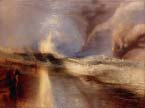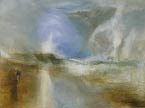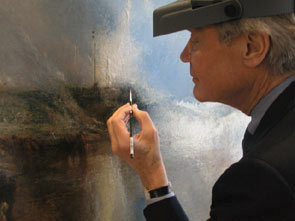
june 14–september 7, 2003
Conservation of Rockets and Blue Lights
Turner: The Late Seascapes was inspired by the Clark's dramatic painting Rockets and Blue Lights (Close at Hand) to Warn Steamboats of Shoal Water. Like many Turner paintings, Rockets and Blue Lights had been plagued with condition problems, but it has been completely conserved, and the results will be revealed for the first time this summer.
In a 1962 report to the Clark Art Institute's trustees, former Clark Director Peter Guille wrote, "Our Turner has turned out to be a very ill picture." Tragically, much of the disfiguration of the Clark's painting seems to have been wrought by the well-meaning hands of restorers attempting to retard its inevitable deterioration. It has long been recognized that Rockets and Blue Lights was retouched at an unknown date, perhaps to mask injury to Turner's original paint layers. Several campaigns of restoration apparently took place over a period of decades before Mr. and Mrs. Clark purchased the painting in 1932. These past interventions, which included the application of additional lining canvases to the back of the painting, radically altered the picture's appearance as well as undermined its structural integrity.
In 2001 the Clark, in association with the Williamstown Art Conservation Center, embarked on a careful analysis, which determined that approximately 75 percent of the surface of the painting was not the work of Turner but instead some past restorer. An expert team assembled at the Clark resolved that the best course of action was to restore the painting once and for all, removing the overpainting (the layers of added paint) and discolored varnish.
David Bull, a leading painting conservator with many years of experience restoring Turner paintings, began this important project in the spring of 2002. Bull first removed the thick natural resin varnish, which had discolored, and then carefully removed the layers of overpaint. After almost eight months of treatment, he successfully removed all indisputable paint not applied by Turner himself.
The results are extraordinary, the painting once again animated by Turner's striking color harmonies and vibrant brushwork. The right side of the sky, the most damaged portion of the picture, is now archetypal Turner—all brio and bravura, effortless and confident—albeit etched with the indelible pockmarks of previous overcleaning. Most likely, this is Turner's initial painting campaign, during which he sketched what would later have been fleshed out with multiple semi-transparent glazes to become billowing smoke. The delicate glazes and top layers of paint were lost long ago, revealing Turner's quickly brushed underpaint. Smoke, steam, spume, and spray once again swirl centripetally around the image's implosive vortex. The celestial conflagration is now, as it should be, convincingly set deep in space. Despite the prior loss of much of Turner's uppermost layers of paint and glaze, Mr. Bull's sensitive cleaning has restored a semblance of Rockets' original, powerful effect.
Rockets and Blue Lights
before conservation
Rockets and Blue Lights
after conservation
Conservator David Bull works on Rockets and Blue Lights



